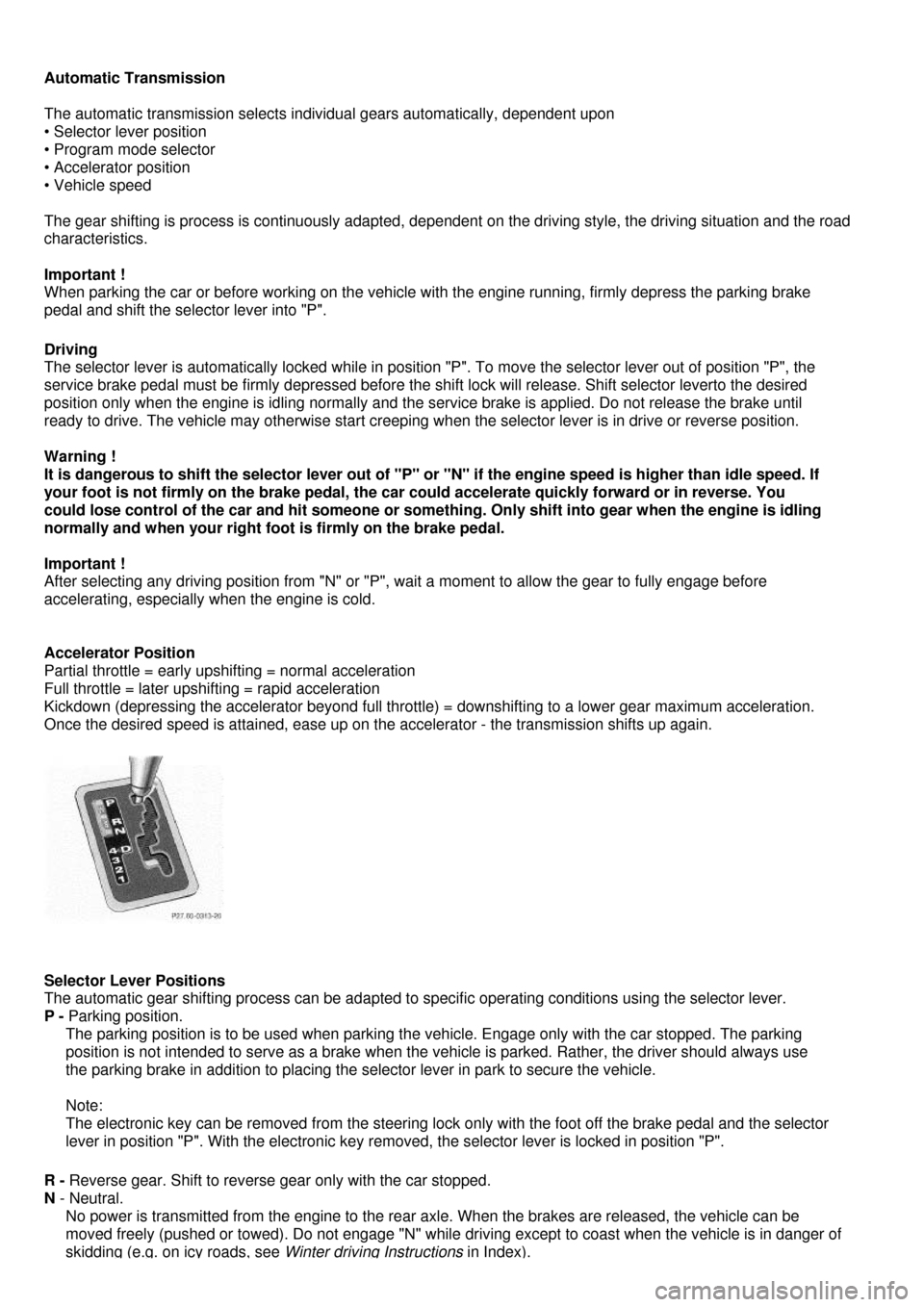warning MERCEDES-BENZ C-Class 2000 W202 Owner's Guide
[x] Cancel search | Manufacturer: MERCEDES-BENZ, Model Year: 2000, Model line: C-Class, Model: MERCEDES-BENZ C-Class 2000 W202Pages: 130, PDF Size: 2.43 MB
Page 64 of 130

Garage Door Opener
1. Integrated remote control transmitter
2. Portable remote control transmitter
Warning !
When programming a garage door opener, the door moves up or down. When programming or operating
the remote control make sure there is no possibility of anyone being harmed by the moving door.
The built-in remote control is capable of operating up to three separately controlled objects.
Notes:
Certain types of garage door openers are incompatible with the integrated opener. If you should experience
difficulties
with programming the transmitter, contact your authorized Mercedes-Benz dealer or call Mercedes-Benz Customer
Assistance Center (in the U.S.A. only) at 1-800-FOR-MERCedes. For operation in the USA only:
This devise complies with Part 15 of the FCC Rules. Operation is subject to the following two conditions:
(1) This device may not cause harmful interference, and (2) this device must accept any interference received,
including interference that may cause undesired operation. Any unauthorized modification to this device could void
the user's
authority to operate the equipment.
Programming or reprogramming the integrated remote control:
1. Turn electronic key in steering lock to position 1 or 2.
2. Press and hold one button of the integrated remote control located on the sun visor until its control light begins to
flash at a
rate of about once a second. Continue holding down the button.
Note:
The light blinks immediately if the integrated remote control is being programmed
for the first time, or if its memory was previously erased. If you
are reprogramming a previously used button, the light will flash after
about 20 seconds.
3. Aim portable remote control transmitter at the integrated remote control transmitter to be programmed. While still
holding down the button on the transmitter on the inside rear view mirror, press down the button on you r portable
remote control transmitter, until the integrated remote control light starts to flash rapidly. This means that the
integrated transmitter has accepted the frequency and code of the portable transmitter.
4. If you wish, repeat the procedure for each remaining button.
Note:
If the garage door opener is equipped with the "rolling code feature", it needs to be trained to accept the remote
control
command. To do so, the assistance of a second person is required.
1. Locate training button (part of the opener unit in the garage).
2. Press and hold training button until training light next to the button begins to flash (in two seconds).
3. Now have the second person press and hold the previously programmed button on the integrated remote control
transmitter until the training light on the garage door opener is lit continuously (in two seconds).
4. Release and press the programmed button on the integrated remote control transmitter once again to turn off
the training light in the garage door opener.
5. Confirm the garage door operation by pressing the programmed button on the integrated remote control
transmitter.
Page 66 of 130

Cellular Telephone
The vehicle is prepared for the installation of a cellular telephone. For further information and installation contact your
authorized Mercedes-Benz dealer.
Warning !
Some jurisdictions prohibit the driver from using a cellular telephone while driving a vehicle. Whether or not
prohibited by law, for safety reasons, the driver should not use the cellular telephone while the vehicle is in
motion. Stop the vehicle in a safe location before answering or placing a call.
Page 67 of 130

Drinking and Driving
Warning !
Drinking and driving can be a very dangerous combination. Even a small amount of alcohol or drugs can
affect your reflexes, perceptions and judgement. The possibility of a serious or even fatal accident is
sharply increased when you drink and drive. Please don't drink and drive or allow anyone to drive after
drinking.
Parking Brake
To engage, firmly depress parking brake pedal. When the electronic key is in steering lock position 2, the brake
warning lamp in the instrument cluster should come on brightly. To release the parking brake, pull handle on
instrument panel. The brake warning lamp in the instrument cluster should go out. A warning sounds, if you start
to drive without having released the parking brake. Also see Brake Warning Lamp Test in Index.
Driving Off
Apply the service brakes to test them briefly after driving off. Perform this procedure only when the road is clear
of other traffic. Warm up the engine smoothly. Do not place full load on the engine until the operating temperature has
been reached. When starting off on a slippery surface, do not allow one drive wheel to spin for an extended period
with the ASR or ESP switched off. Doing so may cause serious damage to the drive train which is not covered by
the Mercedes - Benz Limited Warranty.
Warning !
Keep driver's foot area clear at all times. Objects stored in this area may impair pedal movement.
Page 68 of 130

Automatic Transmission
The automatic transmission selects individual gears automatically, dependent upon
• Selector lever position
• Program mode selector
• Accelerator position
• Vehicle speed
The gear shifting is process is continuously adapted, dependent on the driving style, the driving situation and the road
characteristics.
Important !
When parking the car or before working on the vehicle with the engine running, firmly depress the parking brake
pedal and shift the selector lever into "P".
Driving
The selector lever is automatically locked while in position "P". To move the selector lever out of position "P", the
service brake pedal must be firmly depressed before the shift lock will release. Shift selector leverto the desired
position only when the engine is idling normally and the service brake is applied. Do not release the brake until
ready to drive. The vehicle may otherwise start creeping when the selector lever is in drive or reverse position.
Warning !
It is dangerous to shift the selector lever out of "P" or "N" if the engine speed is higher than idle speed. If
your foot is not firmly on the brake pedal, the car could accelerate quickly forward or in reverse. You
could lose control of the car and hit someone or something. Only shift into gear when the engine is idling
normally and when your right foot is firmly on the brake pedal.
Important !
After selecting any driving position from "N" or "P", wait a moment to allow the gear to fully engage before
accelerating, especially when the engine is cold.
Accelerator Position
Partial throttle = early upshifting = normal acceleration
Full throttle = later upshifting = rapid acceleration
Kickdown (depressing the accelerator beyond full throttle) = downshifting to a lower gear maximum acceleration.
Once the desired speed is attained, ease up on the accelerator - the transmission shifts up again.
Selector Lever Positions
The automatic gear shifting process can be adapted to specific operating conditions using the selector lever.
P - Parking position.
The parking position is to be used when parking the vehicle. Engage only with the car stopped. The parking
position is not intended to serve as a brake when the vehicle is parked. Rather, the driver should always use
the parking brake in addition to placing the selector lever in park to secure the vehicle.
Note:
The electronic key can be removed from the steering lock only with the foot off the brake pedal and the selector
lever in position "P". With the electronic key removed, the selector lever is locked in position "P".
R - Reverse gear. Shift to reverse gear only with the car stopped.
N - Neutral.
No power is transmitted from the engine to the rear axle. When the brakes are released, the vehicle can be
moved freely (pushed or towed). Do not engage "N" while driving except to coast when the vehicle is in danger of
skidding (e.g. on icy roads, see Winter driving Instructions in Index).
Page 69 of 130

Important !
Coasting the vehicle, or driving for any other reason with selector lever in "N" can result in transmission damage
that is not covered by the Mercedes-Benz Limited Warranty.
D - The transmission automatically upshifts through 5th gear. Position "D" provides optimum driving characteristics
under all normal operating conditions.
4 - Upshift through 4th gear only.
Suitable for performance driving. To shift from position "D" to "4", push selector lever to the left.
3 - Upshift through 3rd gear only.
Suitable for moderately steep hill s. Since the transmission does not shift hi gher than 3rd gear, this gear selection
will allow use of the engine's braking power downhill.
2 - Upshift through 2nd gear only.
For driving in mountainous regions or under extreme operating conditions. This gear selection will allow use of the
engine's braking power when descending steep grades.
1 - In this position, the engine's braking effect is utilized by shifting into 1st gear.
Use this position while descending very steep or l engthy downgrades and only at speeds below 40 mph (60
km/h).
Important !
With selector lever in position "D", "4" or "3", upshifting from 1st to 2nd to 3rd gear is delayed depending on vehicle
speed and engine temperature. This allows the catalytic converter to heat up more quickly to operating temperatures.
During the brief warm-up period this delayed upshift and increased engine noise might be perceived as a malfunction.
However, neither the engine nor transmission are negatively affected by this mode of operation.
The delayed upshift is effective with vehicle speeds below 31 mph (50 km/h) at partial throttle and engine
temperatures below 95°F (35°C). To avoid overrevving the engi ne when the selector lever is moved to a lower driving
range, the transmission will not shift to a lower gear, if the engine's speed limit would be exceeded. In this case there
will be no downshift, even when the vehicle speed reaches t he engine's speed limit of that gear, e.g. by applying the
service brakes. Continue driving in the usual manner. The transmission will then shift down automatically.
To prevent the engine from laboring at low RPM when driv ing uphill gradients or with your vehicle heavily loaded, the
automatic transmission will downshift when necessary to maintain engine RPM within the best torque range.
Warning!
On slippery road surfaces, never downshift in order to obtain braking action. This could result in drive wheel
slip and reduced vehicle control. Your vehicle's AB S will not prevent this type of loss of control.
Warning !
On slippery road surfaces, never downshift in order to obtain braking action. This could result in rear
wheel slip and reduced vehicle control. Your vehicle' s ABS will not prevent this type of loss of control.
Maneuvering
To maneuver in tight areas, e.g. when pulling into a parki ng space, control the vehicle speed by gradually releasing
the
brakes. Accelerate gently and never abruptly step on the ac celerator. To rock a vehicle out of soft ground (mud or
snow),
alternately shift from forward to revers e, while applying slight partial throttle. Rocking a vehicle free in this manner
may
cause the ABS malfunction indicator lamp to come on. Turn off and restart the engine to clear the malfunction
indication.
Stopping
For brief stops, e.g. at traffic lights, leave the transmission in gear and hold vehicle with the service brake. For longer
stops with the engine idling, shift into "N" or "P" and hold the vehicle with the service brake. When stopping the
vehicle
on an uphill gradient, do not hold it with the accelerator, use the brake. This avoids unnecessary transmission heat
build up.
Warning !
Getting out of your vehicle with the selector lever not fully engaged in position "P" is dangerous. Also,
when parked on an incline, position "P" alone may not prevent your vehicle from moving, possibly hitting
people or objects. Always set the parking brake in a ddition to shifting to position "P". When parked on
an incline, also turn front wheel against curb.
Page 71 of 130

Cruise Control
Cruise Control
Any given speed above approximately 25 mph (40 km/h) can be maintained with the cruise control by operating the
lever.
1. Accelerate and set:
Lift lever briefly to set speed. Hold lever up to accelerate.
2. Decelerate and set:
Depress lever briefly to set speed. Hold lever down to decelerate.
Normally the vehicle is accelerated to the desired speed with the accelerator. Speed is set by briefly pushing
the lever to position 1 or 2. The accelerator can be released. The speed can be increased (e.g. for passing)
by using the accelerator. After the accelerator is released, the previously set speed will be resumed
automatically. If a set speed is to be increased or decreased slightly, e.g. to adapt to the traffic flow, hold lever in
position 1 or 2 until the desired speed is reached, or briefly tip the lever in the appropriate direction for
increases or decreases in 0.6 mph (1 km/h) increments. When the lever is released, the newly set speed remains.
3. Cancelling
To cancel the cruise control, briefly push lever to position 3.
When you step on the brake pedal or the vehicle speed drops below approx. 25 mph (40 km/h), for example when
driving upgrade, the cruise control will be cancelled. If the cruise control cancels by itself and remains inoperative
until the engine is restarted, have the system checked at your authorized Mercedes-Benz dealer as soon as
possible.
4. Resume
If the lever is briefly pushed to position 4 when driving at a speed exceeding approx. 25 mph (40 km/h), the vehicle
resumes the speed which was set prior to the cancellation of the cruise control. The last memorized speed is
cancelled when the electronic key in the steering lock is turned to position 1 or 0.
Note:
If the engine does not brake the vehicle sufficiently while driving on a downgrade, the speed you set on the cruise
control may be exceeded. In this case the automatic transmission shifts down (max. to 3rd gear) to maintain the set
cruise control speed by using the engine's braking power. As soon as the grade eases, the automatic transmission
shifts up again dependent on the selector lever position. Nevertheless, in some cases you may have to step on the
brake pedal to slow down. In this case the cruise control is switched off. Use the lever to resume the previously set
speed.
Caution !
Moving gear selector lever to position "N" switches the cruise control off.
Warning !
Only use the cruise control if the traffic and weather conditions make it advisable to travel at a steady speed.
• The use of cruise control can be dangerous on winding roads or in heavy traffic because conditions do not
allow safe driving at a steady speed.
• The use of cruise control can be dangerous on slippery roads. Rapid changes in tire adhesion can result
in wheel spin and loss of control.
The "Resume" function should only be operated if the driver is fully aware of the previously set speed and
wishes to resume this particular preset speed.
Page 72 of 130

Charge Indicator Lamp
Should the charge indicator lamp fail to come on prior to starting when the electronic key is in steering lock position 2
or should it fail to go out after starting or during operati on, this indicates a fault which must be repaired at an
authorized Mercedes-Benz dealer immediately.
If the charge indicator lamp comes on while the engine is ru nning, this may indicate that the poly-V-belt has broken.
Should this condition occur, the poly-V-bel t must be replaced before continuing to operate the vehicle. Otherwise, the
engine will overheat due to an inoperative water pump which may result in damage to the engine.
Do not continue to drive the vehicle with the charge indicator lamp illuminated. Doing so could result in serious engine
damage that is not covered by the Mercedes-Benz Limited Warranty.
Low Engine Oil Level Warning Lamp
With the electronic key in steering lock position 2, the o il level warning lamp comes on. It should go out immediately
when the engine is running.
If the warning lamp does not go out after starting the engi ne, or comes on with the engine running and at operating
temperature, the engine oil level has dropped to approximately the minimum mark on the dipstick.
When this occurs, the warning lamp will first come on intermittently and then stay on if the oil level drops further.
If no oil leaks are noted, continue to drive to the nearest service station where the engine oil should be topped to the
"full" mark on the dipstick with an approved oil.
The low engine oil level warning light should not be ignored. Extended driving with the light illuminated could result in
serious engine damage that is not covered by the Mercedes -Benz Limited Warranty. In addition to the warning lamp,
the engine oil level should be periodically checked with t he dipstick (or via the odometer display - Model C280 and
C43 AMG only), for example during a fuel stop, or before a long trip (see Engine Oil Level, Checking in Index)
Page 73 of 130

Engine Oil Consumption
Engine oil consumption checks should only be made after the break-in period. During the breaking period, higher oil
consumption may be noticed and is normal. Frequent driving at high engine speeds results in increased consumption.
Fuel Reserve and Fuel Cap Placement Warning Lamp
With the electronic key in steering lock position 2, the fuel reserve warning lamp comes on. It should go out
immediately when the engine is running.
If the warning lamp does not go out after starting the engine, or if it comes on while driving, it indicates that the fuel
level is down to the reserve quantity of approximately 2.1 gal (8 liters).
The warning lamp blinks when the fuel c ap is not closed, or a fuel system leak has been detected. Retighten cap and
see if lamp goes out.
If the warning lamp continues to blink after closing the fuel cap correctly, hav e the fuel system checked at your
authorized Mercedes-Benz dealer as soon as possible.
Leaving the engine running and the fuel cap open can cause the "Check Engine" lamp to illuminate).
Tachometer
Red marking on tachometer: Excessive engine speed. Avoid th is engine speed, as it may result in serious engine
damage that is not covered by the Mercedes-Benz Limited Warranty. For engine protection, the fuel supply is
interrupted if the engine is operated within the red marking.
Seat Belt Warning Lamp
With the electronic key in steering lock position 2, the warning lamp comes on, and a warning sounds for a short time
if the drivers seat belt is not fastened. After starting the engine, the warning lamp blinks for a brief period to remind
the driver and passengers to fasten seat belts.
Page 74 of 130

Outside Temperature Indicator
The temperature sensor is located in the front bumper area. Due to its location, the sensor can be affected by road or
engine heat during idling or slow driving. This means that the accuracy of the displayed temperature can only be
verified by comparison to a thermometer placed next, to the sensor, not by comparison to external displays (e.g. bank
signs etc.).
Adaptation to ambient temperature takes place in steps and depends on the prevailing driving conditions (stop-and-
go or moderate, constant driving) and amount of temperature change.
Warning !
The outside temperature indicator is not designed to serve as an Ice-Warning Device and is therefore
unsuitable for that purpose. Indicated temperatures just above the freezing point do not guarantee that the
road surface is free of ice.
Coolant Temperature Gauge
If the antifreeze mixture is effective to -22°F (-30°C), the boiling point of the c oolant in the pressurized cooling system
of your vehicle is approx. 266°F (130°C). During severe operating conditions and stop-and-go city traffic, the coolant
temperature may rise close to the red marking. The engine should not be operated with the coolant temperature in
the red zone. Doing so may cause serious engine damage wh ich is not covered by the Mercedes-Benz Limited
Warranty.
Warning !
• Driving when your engine is badly overheated can cause some fluids which may
have leaked into the engine compartment to catch fire. You could be seriously burned.
• Steam from an overheated engine can cause serious burns and can occur just by opening
the engine hood. Stay away from the engine if you see or hear steam coming from it.
Turn off the engine, get out of the vehicle and do not stand near the car until it cools down.
Page 75 of 130

Low Engine Coolant Level Warning Lamp
With the electronic key in steering lock position 2, the warning lamp comes on.
It should go out when the engine is running. If the warning la mp does not go out after starting the engine, or if it
comes on while driving, then the coolant level has dropped below the required level. If no leaks are noticeable and
the engine temperature does not increase, continue to driv e to the nearest service station and have coolant added to
the coolant system (see Index).
The low engine coolant level warning light should not be ignored. Extended driving with the light illuminated may
cause serious engine damage not covered by the Mercedes-Benz Limited Warranty.
In cases of major or frequent minor coolant loss, have t he cooling system checked at your authorized Mercedes-Benz
dealer as soon as possible.
Note:
Do not drive without coolant in the cooling system. T he engine will overheat causing major engine damage. Monitor
the coolant temperature gauge while driving.
Warning !
Do not spill antifreeze on hot engine parts. Antifreeze contains ethylene glycol which may burn if it comes into contact
with hot engine parts. You can be seriously burned.
Low Windshield and Headlamp Washer System Fluid Level Warning Lamp
With the electronic key in steering lock position 2, the warning lamp comes on. It should go out when the engine is
running. If the warning lamp does not go out after starting the engine, or if it comes on while driving, the level of the
reservoir has dropped to approx.1/4 of the total volume. T he reservoir should be refilled with MB Windshield Washer
Concentrate "S" and water (or commercially available premixed windshield washer solvent/antifreeze, depending on
ambient temperature - see Index) at the next opportunity. The reservoir fo r the windshield and headlamp washer
systems is located in the engine compartment.